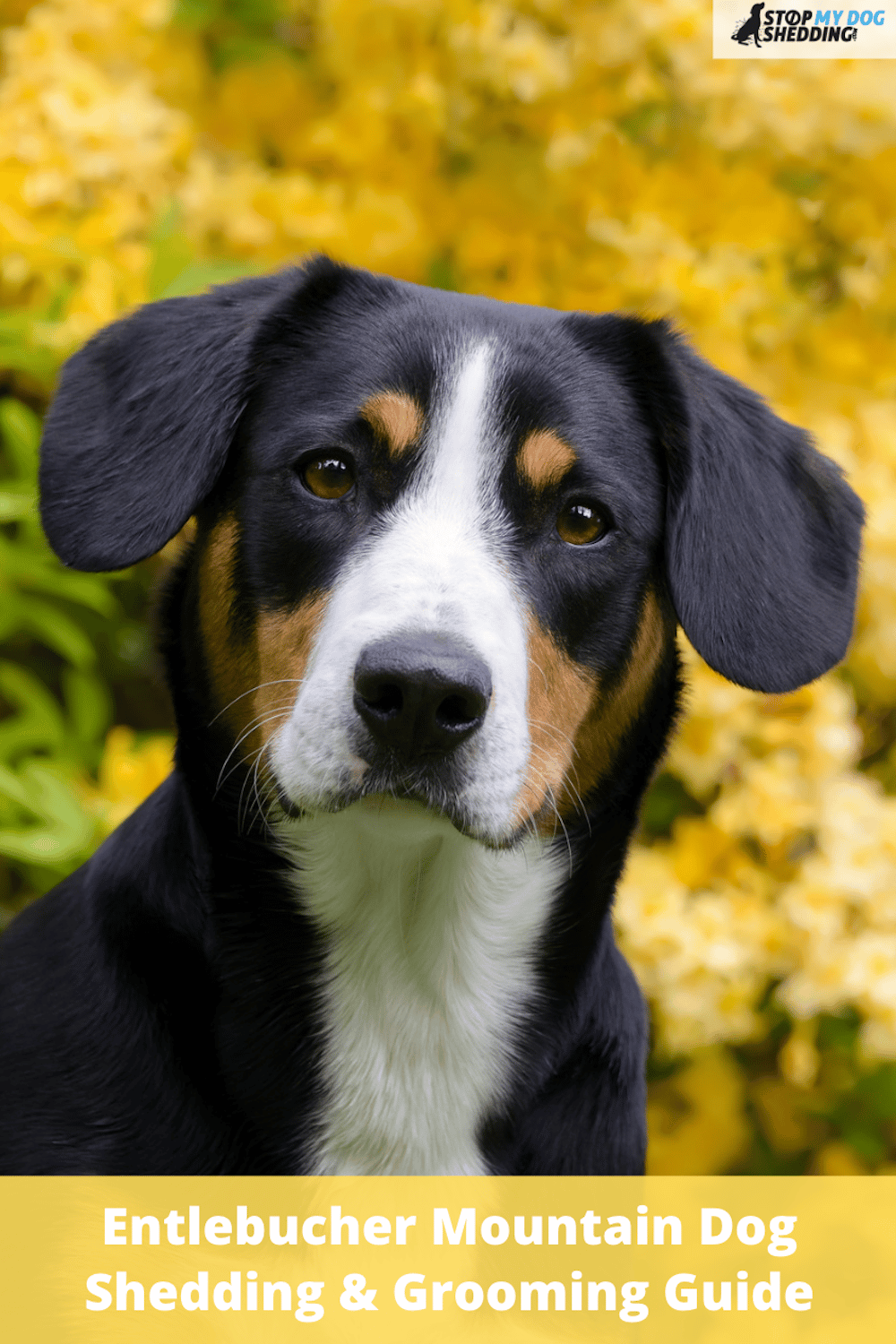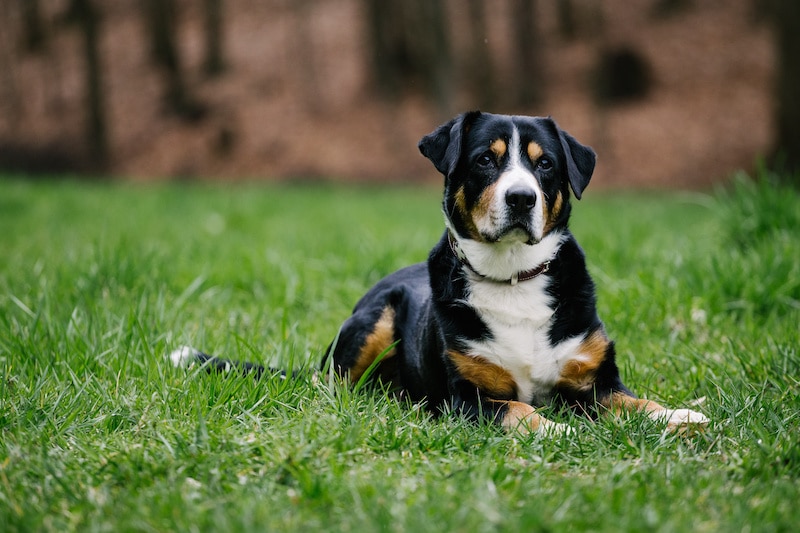The Entlebucher Mountain Dog, also known as the Entlebucher Sennenhund, is a mid-sized Swiss canine that’s related to the Bernese Mountain Dog (one of the heaviest shedders of all).
Thankfully, however, Entles don’t shed quite as much as a Bernese, and one of the reasons for that is that they aren’t as big of a dog, so there’s less surface area for the fur to grow.
That said, Entlebucher Mountain Dogs have a thick, short double coat that sheds, so you will notice fur floating around the home. As for controlling it, the best and simplest method is regular brushing, but there are some other methods, all of which I’ll show you in this guide.
Let’s start by discussing how much shedding you should expect to see if you adopt an Entle, and then I’ll give you some actionable tips on keeping your home as fur-free as possible.
Recommended: Go here to see our top-rated dog hair blow dryers
Entlebucher Mountain Dog Shedding
The Entlebucher Mountain Dog isn’t the heaviest shedding dog breed, but it’s far from the lowest. Overall, you should expect to deal with moderate-to-high shedding.
The Entlebucher Mountain Dog, as mentioned in the intro, is related to the Bernese Mountain Dog, which is one of the heaviest shedding breeds in dogdom.
However, it’s also related to other Sennenhund breeds, including the Appenzeller Mountain Dog and the Greater Swiss Mountain Dog, and neither of those shed as heavily as the Bernese.
So, generally speaking, the Entle takes more after the latter two breeds than the Bernese Mountain dog in terms of fur loss.
As for why it sheds in the first place, the short answer is: because that’s just what dogs do! All dogs shed at least some fur, so it’s impossible to escape this completely.
However, some dogs shed more than others, and factors like the breed’s hair growth cycle, coat type, time of year, diet, and numerous other factors can contribute to the rate of shedding.
In this case, the Entle has a thick, double coat, which means it has a lot more fur on its body than a dog with thinner hair or a single coat, and therefore it has more fur to lose.
The Entlebucher also has short fur. And despite what you might think, short-coated dogs can shed more frequently than their longer-haired counterparts.
The reason? It all has to do with how dogs grow hair. All dogs go through a four-stage cycle to develop fur. The stages include anagen, catagen, telogen, and exogen.
When a dog grows longer fur during anagen, it takes it that much longer to get through the other three stages. Considering that one stage, telogen, is a resting stage, this means a dog keeps its hair longer before finally entering exogen and shedding that fur.
A short-coated dog typically goes through the four stages much faster since its hair never grows to the same lengths as longer-haired breeds. Thus, the rate of shedding increases.
The last factor that’s working against the Entlebucher Mountain Dog being a low-shedding canine is that this breed is double-coated.
A double-coated canine typically blows its coat (AKA sheds heavily) twice per year.
The first time this happens is in the summer as the weather begins to warm. Your Entle will dump its bulky winter coat to breathe easy for the summer.
From there, several months will pass without incident; then your Entle will blow its coat again in the winter. Its summer coat is too light, so the dog grows back its bulk.
And the cycle repeats again next summer.
Both instances of seasonal shedding lead to an increased rate of loose dog hair for several weeks at a clip. So you’ll need your vacuum ready during those periods!
Grooming Your Entlebucher Mountain Dog
Normally, a short-coated breed like the Entle would be a breeze to brush because you don’t have to worry about knots or tangles, given there’s so little fur.
However, as you’ll recall from the last section, the Entle has thick fur. So those knots and tangles you didn’t have to worry about? Now they can become a daily problem.
That said, Entles still aren’t difficult to groom; they just take a bit longer to brush, given the thickness of their coat. And the right brush can make a world of difference here.
What’s the best brush?
The best brush for keeping your Entlebucher’s fur tangle-free is a slicker brush. These are simple, cost-effective, and easy-to-use brushes that work really well for this coat type.
You will have to put some elbow grease into combing your Entle to ensure you reach both layers of its thick fur, but it’s not hard.
If you see a knot or mat, gently brush the area using a wide-toothed comb and some dog-friendly detangling lotion. But whatever you do, avoid ripping or yanking out knots, as all you’ll do is cause your dog pain.
Should you have a stubborn knot that doesn’t want to come out, you might want to trim out the knot with dog-grooming scissors. Or there are some great de-shedding and de-matting tools available, and the link I just shared takes you to a list of our top picks.
How often should you brush the Entlebucher?
I would suggest brushing this fuzzy, thick dog every two days. That frequency should prevent painful mats and knots from developing and help you control the shedding.
When your Entle blows its coat, ramp up the rate of brushing to every single day for the next several weeks. Otherwise, you’re likely to notice fur floating around.
As for bathing, Entles don’t need baths all that often. You can get away with bathing yours monthly. Even waiting every six weeks should be fine. However, if your dog stinks or is covered in muck, wash him earlier than that. And always use a dog-friendly shampoo.
Also worth noting is that it’s a good idea to refrain from towel-drying the Entlebucher after a bath, even if that is usually okay for shorter-furred dogs. This is because the canine’s thick coat can become matted and tangled before you even get it dry.
If you’re willing to splurge a bit, a good tool to use after bathing is a dog hair blower. Not only can this avoid the towel drying issues (pulling the hair and matting), but it can remove a TON of loose fur. And if you follow that up with a brush, you’ll have a brand new dog!
How to Reduce Excessive Shedding
The single best way to manage dog shedding is with a proper grooming routine. And in particular, brushing, as this can benefit your dog in numerous ways.
For starters, when you take the time each day (or several times per week) to comb through the thick, double coat of the Entlebucher, you’re helping spread your dog’s skin oils.
This moisturizes the skin underneath all that fluff, keeping it free of scaliness and dryness. Your dog will be less likely to itch, especially obsessively.
When a dog doesn’t itch like crazy, more of its fur usually stays attached to its body.
Grooming also allows you to collect the dead fur that your Entle was about to lose anyway and prevent those tufts of fluff from floating all over your house. Your furniture will be cleaner, your wardrobe will have fewer strands of dog hair on it, and you will notice the difference.
However, there are some other effective ways to reduce shedding, and we’ve put together a complete guide to reducing shedding if you want to know more.
But in short, aside from grooming, one of the most effective ways to limit excess fur loss is by enduring your Entle is on an optimal diet, which your vet should be able to help you with. You can also see our list of top-rated dog foods that specifically cater to high shedders.
Aside from making sure your dog has access to a balanced, nutritious diet, foods that contain Omega 3 fatty acids can help reduce shedding.
It’s also important to avoid feeding your Entle food that’s primarily filler or that contains too many artificial ingredients, preservatives, or additives, as this can see your dog develop allergies. And a dog with a food allergy can become itchy and uncomfortable, which can lead to scratching and increased shedding. So, getting your dog’s diet right is key.
What if none of that works?
Chances are that if you have a solid grooming routine in place and your dog’s diet is optimal, you shouldn’t notice too much hair loss, except during seasonal coat-blowing periods.
However, if you’re concerned there’s a problem, it may also be worth bringing your Entlebucher to the vet because some medical conditions can lead to an accelerated rate of shedding. Some, like a flea infestation, are not that serious, but others can be. A checkup should clear your dog of any health maladies, so this can be worthwhile in some cases.
About Entlebucher Mountain Dogs
If you’re considering an Entle at this point, you might be pondering whether this is the dog you should adopt. In this section, we’ll take a closer look at this breed to help you decide.
The Entlebucher Mountain Dog is a mid-sized Sennenhund from Switzerland that is sometimes called the Entlebucher Cattle Dog in English. And it belongs to the herding group, which means it’s a natural-born herder.
According to the American Kennel Club, Entles are enthusiastic, smart, and loyal. The dog is also extremely affectionate, playful, adaptable, and vigilant.
Even still, I wouldn’t recommend an Entlebucher for an apartment for a multitude of reasons.
For starters, it’s on the bigger side at 20 inches tall and 65 pounds (which are the measurements for both males and females). So an apartment might feel a little too small.
What’s more, Entles are also extremely energetic, so they cannot expend their energy inside a small apartment. You can always let them out at the local dog park, but an enclosed backyard is better for this canine.
How are they with other animals? Entles are good-natured enough that they appreciate the company of other canines, but they will still need socialization first.
I wouldn’t mix smaller dogs with the Entlebucher, though. This pup can get so rambunctious and rough when playing that a small breed could easily end up hurt.
Entles can coexist with cats as well, especially with proper socialization. However, for the above reason, it might not be best to add the Entlebucher to a house with cats.
What about barking? The Entle has a booming, deep bark that you will hear a lot, especially when the dog is exposed to new stimuli. So you might want to consider behavioral training if the barking is getting to be too much, especially if you live close to others.
Here’s a YouTube video I found that goes into more detail on this breed:
Recommended: Go here to see our top-rated dog hair blow dryers
Bottom Line
The Entlebucher Mountain Dog from Switzerland is a herding dog that sheds about as much as its related Sennenhunds; the Appenzeller Mountain Dog, and Greater Swiss Mountain Dog. However, not quite as much as the heavy shedding Bernese Mountain Dog.
This smaller Sennenhund is sweet, smart, and vigilant. So while the Entle’s coat can be a pain to groom, and it sheds, its temperament and kindheartedness more than make up for it.
Is an Entlebucher Mountain Dog part of your family? If so, let us know what your experience has been with this beautiful dog in the comments section below!













Please note: By submitting a comment using the above comment form, you confirm that you agree with the storage and handling of your data by this site as detailed in our Privacy Policy.